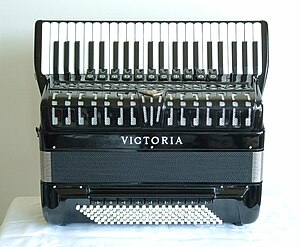Accordion/How to Handle the Accordion
Many accordions have a reputation for being manufactured exceedingly well, and with proper maintenance and preventative measures, it can last decades. Aside from the cost of repairs, you might have difficulty finding someone skilled enough to repair the instrument! A little bit of care goes a long way.
- When lifting up and putting down your accordion, always be careful; hold the instrument with both hands (by the straps, if they are sturdy). Dropping an accordion even from a small height can be disastrous. When transporting the instrument, it is advisable to lock the bellows straps on the top and bottom (usually found on all but the oldest accordions) so the bellows don't come out. Be careful not to push in the bass buttons when carrying your accordion; it can damage the bass mechanisms.
- Always store your accordion in a case if you can. This helps keep it away from humidity and other things that might damage the instrument. Try to keep it out of too much heat, cold, or humidity. The reeds inside the accordion might bend out of tune if there's too much humidity.

- If you can't store the accordion in a case, then always place it on a hard flat surface (like a table), with the keyboard facing up perpendicular to the floor. (The bass side of the instrument usually little protrusions at the corners so you and put it down safely.) Make sure to always store it the right way up. An accordion is constructed with leather flaps (valves) that seal the back pressure from the reed that is not sounding in the current direction of bellows movement. Storing the instrument upright allows the valves to be preserved. Storing in other orientations will cause one set of valves to be bent under gravity, ruining the tone and needing more early refurbishment.
- Avoid extreme temperatures. If you would be uncomfortable in the room, so would your accordion. Parts of your accordion are held together by wax or glue joints that can melt in heat. Don't leave the instrument near a ventilator, heater, or near a sunny window, and especially don't leave it in the trunk of a car, because the temperature is uncontrollable and unstable. Also, the accordion may suffer from jolts while in the trunk, especially if not stored the correct way up.
- If you've just taken the accordion in from from the cold, take it out of its case and let it "warm up" before playing for at least half an hour. Moisture may collect on the reeds from the sudden temperature change, and you want to give it time to dissipate or else the water might harm the reeds.
- Avoid moisture. Do not play your accordion in the rain, or take it to the beach. The salty air can cause the reeds to rust rapidly.
- Don't store in an attic or basement. Be aware that older accordions found in attics may contain harmful mould in the bellows. When played, the mould is propelled towards the player's face.
- Avoid dust. As the accordion is based on drawing air into the instrument, if you play in dusty environments, the dust will get into the accordion. As well, if you are storing an accordion, cover it so dust will not get on it. In addition, as mentioned earlier, the acordion should be stored on its button side to keep the valve flaps in good shape.